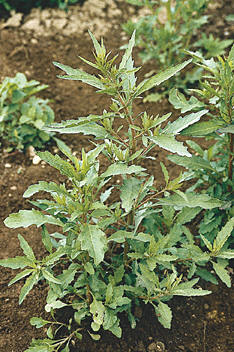Owing to the screen size of your device, you may obtain a better viewing experience by
rotating your device a quarter-turn (to get the so-called "panorama" screen view).
|
This page updated for 2022.
|
Click here for the site directory.
|
|
Please consider linking to this site!
|
Click here to email us.
|
Epazote
(Chenopodium ambrosioides)
About Epazote

This annual is the Latin American “bean herb”, so called because it is almost invariably added to cooking beans. Whether that is for its flavor or for its rumored minimizing of what Julia Child called “the rooty-toot-toot” problem with eating beans is uncertain.
The spice expert Gernot Katzer writes of epazote: “Epazote’s fragrance is strong, but difficult to describe. People would often compare it with (in no particular order) citrus, petroleum, savory, mint or putty. I think it smells like epazote.” Other sources describe its flavor with “The bruised leaves emit an unpleasant foetid odour.” (It is said that the word epazote comes from a Nahuatl term meaning “skunk sweat”.) But don’t be put off the herb by such descriptions: many flavorings that are overtly repellent are excellent additions to cooking in small or dilute quantities (consider cilantro, or asafoetida). There is also some room for suspicion that this is another of those aromas that different people sense very differently, probably depending on their genes. We find it has a sort of pine/resin quality; you may think something else altogether.
Mexican cooking expert Diana Kennedy says that to cook black beans without epazote is “unthinkable”, adding that when a recipe calls for epazote, there is no substitute. For more discussion of the herb and its uses, see the links listed below.
Cultivars
We have not found any evidence of named types.
Planting
Epazote is not fussy about soil, but wants full sun and good drainage. As with most herbs, a less-than-rich soil produces the best and most concentrated flavor in the leaves. It can grow fairly large, up to 2 to 3 feet tall, so give it a good-size pot. And you really want it confined to a pot: it is considered highly invasive.
Sow a few seeds in the pot, and after emergence thin to the best plant. Germination rates are usually very good, and seedlings should appear within a few days of sowing the seed.
Growing
Epazote is usually described as an annual, but apparently can be perennial given warm winter temperatures (as we would have indoors)—so take care of your plant and it might last you some years.
Watering information is scanty, suggesting that the plant needs neither unusually high nor unusually low amounts, though it is not considered drought-hardy.
When harvesting, cut the center stem first, to encourage bushing. Prune the plant frequently to prevent flowering and assure a continuing supply of leaf, but don’t harvest more than half the plant at a time. And, as with most herbs, we don’t want to fertilize it, lest we weaken the flavor.
When adding epazote to a cooked dish, toss it in shortly before cooking completes, say 15 minutes before.
Relevant Links
Besides any links presented above on this page, the following ought to be especially helpful.
Epazote [archived copy] - from Gernot Katzer’s immensely valuable Spice Dictionary
Plants For a Future Database: Epazote - lots of data on the plant, and links to yet more
Epazote [archived copy] - a use-oriented article, this from "Kate’s Global Kitchen"
Epazote - another few use notes from a page on Mexican cookery
Return to the top of this page.
If you find this site interesting or useful, please link to it on your site by cutting and pasting this HTML:
The <a href="https://growingtaste.com/"><b>Growing Taste</b></a> Vegetable-Gardening Site
—Site Directory—
Search this site, or the web
-
Background Information
about the purposes and design of this site
- Site Front Page
-
Introduction

- An Apologia: why one should cultivate one's garden
- Deep-Bed Gardening (forthcoming)
- Container Gardening (forthcoming)
- Vegetarian and Organic Considerations (forthcoming)
-
Recommended Crops for a home garden, by variety
-
Gardening information and aids
-
Miscellaneous Information of interest to the home gardener
Since you're growing your own vegetables and fruits, shouldn't you be cooking them in the best way possible?
Visit The Induction Site to find out what that best way is!
|
If you like good-tasting food, perhaps you are interested in good-tasting wines as well?
Visit That Useful Wine Site for advice and recommendations for both novices and experts.
|

|
This site is one of The Owlcroft Company family of web sites. Please click on the link (or the owl)
to see a menu of our other diverse user-friendly, helpful sites.
|
|
 Like all our sites, this one is hosted at the highly regarded Pair Networks,
whom we strongly recommend. We invite you to click on the Pair link for more information on getting your site or sites hosted on a first-class service.
Like all our sites, this one is hosted at the highly regarded Pair Networks,
whom we strongly recommend. We invite you to click on the Pair link for more information on getting your site or sites hosted on a first-class service.
|
|
All Owlcroft systems run on Ubuntu Linux and we heartily recommend it to everyone—click on the link for more information.
|
Click here to send us email.
Because we believe in inter-operability, we have taken the trouble to assure that
this web page is 100% compliant with the World Wide Web Consortium's
XHTML Protocol v1.0 (Transitional).
You can click on the logo below to test this page!
You loaded this page on
Wednesday, 26 March 2025, at 09:26 EDT.
It was last modified on Sunday, 9 January 2022, at 21:17 EST.
All content copyright ©1999 - 2025 by
The Owlcroft Company

